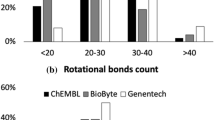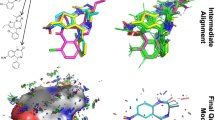Abstract
We have developed a method that combines molecular interaction fields with soft independent modeling of class analogy (SIMCA) Wold:1977 to predict pharmacokinetic drug properties. Several additional considerations to those made in traditional QSAR are required in order to develop a successful QSPR strategy that is capable of accommodating the many complex factors that contribute to key pharmacokinetic properties such as ADME (absorption, distribution, metabolism, and excretion) and toxicology. An accurate prediction of oral bioavailability, for example, requires that absorption and first-pass hepatic elimination both be taken into consideration. To accomplish this, general properties of molecules must be related to their solubility and ability to penetrate biological membranes, and specific features must be related to their particular metabolic and toxicological profiles. Here we describe a method, which is applicable to structurally diverse data sets while utilizing as much detailed structural information as possible. We address the issue of the molecular alignment of a structurally diverse set of compounds using idiotropic field orientation (IFO), a generalization of inertial field orientation Clark:1998. We have developed a second flavor of this method, which directly incorporates electrostatics into the molecular alignment. Both variations of IFO produce a characteristic orientation for each structure and the corresponding molecular fields can then be analyzed using SIMCA. Models are presented for human intestinal absorption, blood-brain barrier penetration and bioavailability to demonstrate ways in which this tool can be used early in the drug development process to identify leads likely to exhibit poor pharmacokinetic behavior in pre-clinical studies, and we have explored the influence of conformation and molecular field type on the statistical properties of the models obtained.
Similar content being viewed by others
References
Wold, S., Sjöström, M. Method for Analyzing Chemical Data in Terms of Similarity and Analogy. In: Chemometrics: Theory and Applications, Kowalski, B.R., (Ed.), ACS Symposium Series, 1977, 52, 243-282.
Clark, R.D., Ferguson, A.M., Cramer, R.D., Persp. Drug Discov. Design. (1998), 9/10/11, 213.
Smith, D.A., van der Waterbeemd, H., Curr. Opin. Chem. Biol., 3 (1999) 372.
Hilgers, A.R., Conradi, R.A., Burton, P.S., Pharm. Res., 7 (1990) 902.
Lipinski, C.A., Lombardo, F., Dominy, B.W., and Feeney P.J., Adv. Drug Del. Rev., 23 (1997) 3.
Palm, K., Luthman, K., Ungell, A. Strandlund, G., Arturssan, P., J. Pharm. Sci., 85 (1996) 32.
Palm, K., Luthman, K., Ungell, A. Strandlund, G., Beigi, F., Lundahl, P., Arturssan, P., J. Med. Chem., 41 (1998) 5382.
Clark, D.E., J. Pharm. Sci., 88 (1999) 807.
Osterberg, T., Norinder, U., J. Chem. Inf. Comput. Sci., 40 (2000) 1408.
Ertl, P., Rohde, B., Selzer, P., J. Med. Chem., 43 (2000) 3714.
Clark, D.E., J. Pharm. Sci., 88, (1999) 815.
Oprea, T.I., Gottries, J., J.Mol. Graphics Modeling., 17 (1999) 261.
Yoshida, F., Topliss, J.G., J. Med. Chem., 43 (2000) 2575.
Lombardo, F., Blake, J.F., Curaolo, W.J., J. Med. Chem., 39 (1996) 4750.
Cramer, R.D., DePriest, S.A., Patterson, D.E., Hecht, P. The Developing Practice of Comparative Molecular Field 76 Analysis in 3D-QSAR in Drug Design: Theory, Methods and Applications. ESCOM, Leiden, 1993.
Cramer, R.D., Patterson, D.E., Bunce, J.D., J. Amer. Chem. Assoc., 110 (1998) 5959.
Martin, Y.C., Kim, K.H., Liu, C.T., Quant. Struc-Act. Relat., 1 (1996) 1.
Klebe, G., Persp. Drug Disc. Design., (1998) 87.
Ekins, S., Durst, G.L., Stratford, R.E., Thorner, D.A., Lewis, R., Loncharich, R.J., Wikel, J.H., J. Chem. Inf. Comput. Sci., 41 (2001) 1578.
Ekins, S., Bravi, G., Ring, B.J., Gillespie, T.A., Gillespie, J.S., VandenBranden, M., Wrighton, S.A., Wikel, J.H., J. Pharmacol. Exp. Thera., 288 (1999) 21.
Segarra, V., López, M., Ryder, H., Palacios, J.M., Quant. Struct.-Act. Relat., 18 (1999) 474-481.
Cruciani, G., Carrupt, P.A., Testa, B., J. Mol. Structure: Theochem., 503 (2000) 17.
VolSurf is distributed by Tripos, Inc., 1699 S. Hanley Road, St. Louis Missouri, U.S.A.
Wessel, M.D., Jurs, P.C., Tolan, J.W., Muskal, S.M., J. Chem. Inf. Comput. Sci., 38 (1998), 726.
Oprea, T.I., Gottries, J., J. Mol. Graphics Modeling, 17 (1999) 261.
Yoshida, F., Topliss, J.G., J. Med. Chem., 43 (2000) 2575.
Sietsema, W.J., Intern. J. Clin. Pharm. Therapy Tox., 27 (1989) 179.
Abraham, M.H., Chadha, H.S., Mitchell, R.C., J. Pharm. Science., 83 (1994) 1257.
Lombardo, F., Blake, J.F., Curaolo, W.J., J. Med. Chem., 39 (1996) 4750.
Jørgensen, F.S., Jensen, L.H., Capion, D., Christensen, I.T. Prediction of Blood-Brain Barrier Penetration. In Rational Approaches to Drug Desig, Höltje, H.-D., and Sippl, W., (Eds.) Prous Science: Barcelona, 2001, pp. 281-285.
SYBYL® 6.8.1 Tripos Inc., 1699 S. Hanley Road, St. Louis, Missouri, 63144, U.S.A.
The Merck Index. 12th Edition on CD-ROM, version 12:3 2000. Chapman & Hall / CRCnetBASE Electronic Publishing Division.
CONCORD was developed by R.S. Pearlman, A. Rusinko, J.M. Skell and R. Balducci at the University of Texas, Austin TX and is available exclusively from Tripos, Inc., 1699 S. Hanley Road, St. Louis Missouri, U.S.A.
Clark, M., Cramer, R.D. III., Van Opdenbosch, N., J. Comp. Chem., 10 (1989) 982.
Gasteiger, J., Marsili., Tetrahedron, 36, (1980) 3219.
Clark, R.D., Leonard, J.M., Strizhev, A. Pharmacophore Models and Comparative Molecular Field Analysis (CoMFA). In Pharmacophore Perception, Development, and Use in Drug Design, Güner, O.F., (Ed), International University Line: La Jolla, 2000, pp. 151-169.
Klebe, G., Abraham, U., Mietzner, T., J. Med. Chem., 37 (1994) 4130.
Hunt, P.A., J. Comp-Aided Mol. Design., 13 (1999) 453.
Confort was developed by R.S. Pearlman and R. Balducci at the University of Texas, Austin TX and is distributed by Tripos, Inc., 1699 S. Hanley Road, St. Louis Missouri, U.S.A.
Boström, J.J., Comp-Aided Mol. Design., 15 (2001) 1137.
Lin, J.H., Lu, A.Y.H., Pharmacol. Rev., 49 (1997) 403.
Author information
Authors and Affiliations
Rights and permissions
About this article
Cite this article
Wolohan, P.R., Clark, R.D. Predicting drug pharmacokinetic properties using molecular interaction fields and SIMCA. J Comput Aided Mol Des 17, 65–76 (2003). https://doi.org/10.1023/A:1024582008908
Issue Date:
DOI: https://doi.org/10.1023/A:1024582008908




